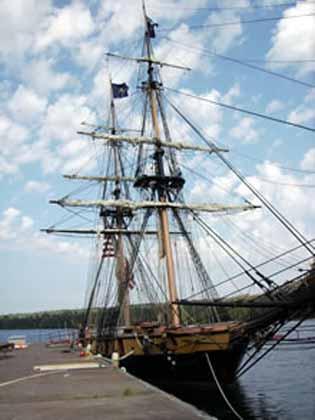A recent visit to Isle Royale National Park by the Niagara, a historically accurate reconstruction of Commodore Oliver Hazard Perry's victorious 1813 flagship, included an unwelcome surprise. Despite efforts to prevent such problems, the ship was harboring some dangerous stowaways.
The ship is owned by the State of Pennsylvania’s Erie Historic Maritime Museum, "a nonprofit educational association striving to preserve and further the education of historic sailing techniques, environmental stewardship, and outreach education programs." It visited Isle Royale under terms of a special use permit that included some specific conditions: the ship would be free of aquatic invasive species, especially the zebra mussel.
As previous articles on the Traveler have explained, zebra mussels—and their relatives named quaggas—pose a serious threat to any body of water where they become established, and they have already caused hundreds of millions of dollars in damage in other parts of the country. Information from Isle Royale notes,
Zebra mussels are a species that are thought to have originated in the Baltic Sea and are believed to have been transported to the waters of North America in ballast water discharged from commercial shipping vessels. Zebra mussels can attach themselves to nearly any surface, including wood, fiberglass, aluminum, steel, rocks, and pipes, and can be transported to a number of other bodies of water, remaining alive for up to a week out of the water. These fingernail-sized mussels can quickly out-compete native species, change water chemistry and turbidity, change oxygen content, and have significant impact on native fish species.
Those are all good reasons for the park and other agencies in the Great Lakes to try to contain the spread of these pests—hence the conditions in the special use permit for the ships visit.
The captain of the Niagara assured park staff that the vessel had been cleaned by a team of volunteer scuba divers while in its home port of Erie, Pennsylvania, and that it was clear of zebra mussels. Alas, good intentions notwithstanding, trouble was lurking beneath the waterline on the ship. According to information from the park,
On the morning of July 27th, park divers inspected the hull of the Niagara while it was docked at the headquarters dock on Mott Island. They discovered several colonies of zebra mussels attached to the hull of the ship aft of midship on the keel and rudder assembly (pintel). Evidence suggested that the mussels had been attached to the vessel for a considerable length of time, which meant that the volunteer divers missed them. The park divers cleaned about 80% of the zebra mussels off the hull before deciding that further cleaning of the ship in a clean harbor might seed the harbor and further spread this fast moving invasive species.
The ship left the harbor the next morning with a new level of appreciation for what is necessary to ensure that a ship is 100% clean of aquatic invasive species. The Niagara then sailed to Duluth, Minnesota, to attend the annual Tall Ships Duluth Festival, where it is hoped that the crew of theNiagara will educate the crews of other tall ships and vessels about the issues related to aquatic invasive species such as the zebra mussel.
The incident illustrates the difficulty in slowing, much less halting, the spread of these invaders to other parts of the country, but it's worth continuing the effort. The consequences in both ecological and economic terms are enormous. If you're a boater, you're a key link in the effort, so we hope you'll get informed and do your part to help.


 Support Essential Coverage of Essential Places
Support Essential Coverage of Essential Places







Comments
Note: the Niagara can not be blamed for introducing zebra mussels to Mott Island at Isle Royale. According to NPS publications, including the 2010 issue of the Isle Royale Greenstone, the zebra mussels were found at Mott Island in September 2009 - almost one year before the Niagara visited the island.